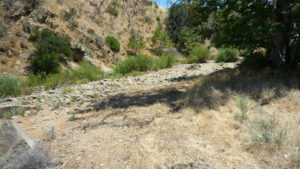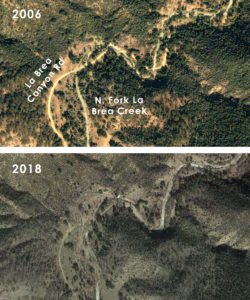
The remnants of La Brea Canyon Road next to North Fork La Brea Creek, a tributary to the Sisquoc River. Photo by Mike Stiles.
Click here to submit a letter supporting non-motorized trails in La Brea Canyon.
Yesterday, the Forest Service announced the release of a draft environmental assessment for the La Brea Restoration Project in the Los Padres National Forest backcountry east of Santa Maria. The project would reopen the area by converting a section of road that was damaged beyond repair and subsequently closed after major flooding nearly 10 years ago to a non-motorized trail along the edge of the San Rafael Wilderness. The project would also improve federally-protected “critical habitat” for endangered California red-legged frogs and southern steelhead in La Brea Creek, a tributary to the Sisquoc River.
Background
In 2009, the La Brea Fire burned much of La Brea Canyon southeast of Highway 166 in the Los Padres National Forest. In the years following the fire, major flooding occurred in the area and heavily damaged La Brea Canyon Road — a rugged, remote dirt road with dozens of creek crossings — as well as a nearby motorcycle trail beyond repair. Last year, the Forest Service proposed the restoration project to convert the damaged road and motorcycle trail to non-motorized trails open to hiking, horseback riding, and mountain biking.
What the Project Would Accomplish

One of many sections of La Brea Canyon Road that was washed away by flooding in the years following the 2009 La Brea Fire as seen from satellite imagery.
The agency recently released its draft environmental assessment which examines the potential impacts of the project and evaluates alternatives — critical steps required by the National Environmental Policy Act. The agency’s proposal to convert the road and trail to non-motorized use would ultimately improve both habitat for threatened and sensitive animals and local water quality while retaining sustainable public access to the area.
ForestWatch supports the Forest Service’s efforts to convert the heavily-damaged road and motorcycle trail near the San Rafael Wilderness to non-motorized trails. The project also comes at a time when the agency has a road maintenance backlog of $117,000,000 and continued budget cuts, so it would help move the agency toward a more sustainable road system over the long term.
The draft environmental assessment also explores alternatives to the agency’s initially-proposed plan. One of these alternatives would establish a new 6-mile-long dirtbike and ATV route along an undisturbed ridgeline through the middle of the Horseshoe Springs Roadless Area. Such an alternative would require an immense amount of environmental documentation and a complex amendment to the Los Padres National Forest Land Management Plan, which protects the area with a “semi-primitive non-motorized” land use zoning classification.

Map depicting where the road and OHV trail would be reclassified as a non-motorized trail. Note also Alternative 4’s proposed new OHV trail along the undisturbed Bear Ridge within an Inventoried Roadless Area. Click to enlarge.
Developing a new off-road vehicle trail through the area would contradict the Forest Service’s plans to restore the area that supports several threatened and sensitive animals as well as an important tributary to the Wild and Scenic Sisquoc River.
How You Can Help
The public now has until August 20 to submit comments on the project. Go to LPFW.org/brea to easily submit a comment online. Urge the Forest Service to select Alternative 1 as they move forward with the project.
The Forest Service will consider the public’s comments before making a final decision sometime later this year.







Comments are closed.